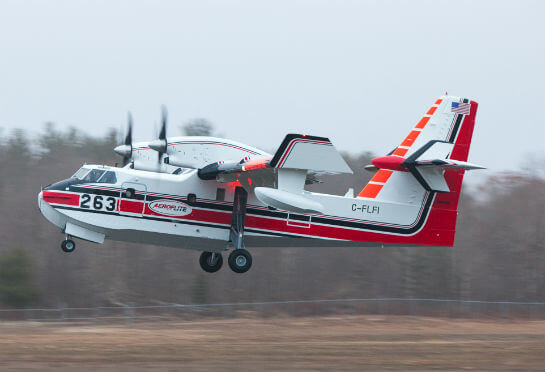Estimated reading time 7 minutes, 44 seconds.
Viking sees a long-term opportunity to manufacture parts and provide in-service support for the worldwide waterbomber fleet. It remains to be seen whether Viking will build new 415 aircraft in the future. Alfredo La Marca Photo
Viking Air of Sidney, B.C., is buying Bombardier’s 415 aircraft program and taking over product support responsibility for the global fleet of legacy CL-215, CL-215T and 415 amphibious aircraft used for aerial firefighting, maritime patrol and search and rescue missions.
Viking Air’s acquisition was announced on June 20, just nine months after Bombardier closed down the 415 final assembly line in North Bay, Ont., after the completion of its 95th and now last 415.
As Bombardier’s aerospace business more narrowly focused on the commercial and business aircraft markets, the Quebec company sold its NATO Flying Training in Canada (NFTC) business to CAE Defence and Security last October and put the waterbomber program up for bids.
The acquisition of the type certificates for the CL-215 and 415 follows a path blazed in 2005 when Viking took over product support for de Havilland Canada’s legacy aircraft models. In 2006, it acquired the type certificates for all out-of-production de Havilland aircraft (DHC-1 through DHC-7), including the Twin Otter, from Bombardier.
Viking Air’s acquisition was announced on June 20, just nine months after Bombardier closed down the 415 final assembly line in North Bay, Ont. Alfredo La Marca Photo
The purchase came three years after Toronto-based Westerkirk Capital Inc. bought Viking Air in 2003 and provided the maintenance, repair and overhaul (MRO) facility with the strength to undertake new strategic acquisitions and investments.
By 2005, Viking already had a long history as a MRO supporting de Havilland utility aircraft and as a Bombardier subcontractor building spare parts for the Beaver and Otter and new wings for the Twin Otter.
As de Havilland’s intellectual property was transferred from Ontario and Quebec to Western Canada, Viking undertook a market survey that identified a niche opportunity for new production Twin Otters with modern systems.
Viking launched development of the Twin Otter Series 400 in 2007, with the first new production aircraft taking off from Calgary on Feb. 16, 2010, and delivered to Zimex of Switzerland in January 2011.
When Nils Christensen founded Viking Air Limited at Victoria International Airport in 1970, a mainstay of his business was maintaining, modifying and rebuilding amphibious aircraft, with a particular focus on the Grumman G-44 Widgeon, G-21 Goose and G-73 Mallard amphibians then in widespread use in B.C., Alaska and the continental United States.
Now, as Viking nears completion of the 100th Twin Otter Series 400, it is revisiting the amphibious aircraft market and has acquired a 50,000-square-foot building near Calgary International Airport. The site will eventually be home to 40 employees who will support a fleet of 170 waterbombers in service with 21 operators in 11 countries around the world.
The final Bombardier 415 was built for American operator AeroFlite. It is seen departing Muskoka Aircraft Refinishing’s paint shop at Little Norway Memorial Airport on Dec. 5, 2015. Andy Cline Photo
Canadair built 125 CL-215s between 1967 and the late 1980s, and then Bombardier invested in the development of the CL-215T equipped with Pratt & Whitney Canada PW123 turboprop engines, also utilized by the Dash 8 Series 300.
The initial customers for the CL-215T conversion kit were Quebec (2) and the Spanish Air Force (14), and then conversions resumed about 10 years ago when Cascade Aerospace converted four piston CL-215s for Alberta and another four for Saskatchewan, which has a fifth conversion underway in Abbotsford today.
The updated Bombardier 415 turboprop was launched in 1991, with the first aircraft flying in December 1993 and first delivery in November 1994.
Customers for the Bombardier 415 include the governments of Manitoba, Ontario, Quebec, and Newfoundland and Labrador in Canada, and Croatia, France, Greece, Italy, Morocco and Spain overseas.
The sole commercial operator is Aero-Flite of Spokane, Wash., a sister company of Conair Aviation, which now has two “Super Scoopers” on long-term contracts with the U.S. Forest Service. Two additional aircraft are available for “call when needed” contracts, all leased from Falko Regional Aircraft Limited of the U.K.
Viking launched development of the Twin Otter Series 400 in 2007, with the first new production aircraft taking off from Calgary on Feb. 16, 2010. Heath Moffatt Photo
Viking sees a long-term opportunity to manufacture parts for the waterbomber fleet and provide ongoing support to the in-service fleet.
There are currently 60 CL-215, CL-215T and 415 aircraft registered in Canada, with two more imported in early June—one of these is now registered to a numbered Alberta company sharing the same address as Viking Air.
Of course, the more intriguing question, “Will Viking re-launch production of the 415?” will take time to answer.
Viking is currently awaiting regulatory approval to close the purchase and “only then will it have its hands on the business,” said a Viking spokesperson.
Bombardier’s challenge was that government orders for the 415 were sporadic and it was saddled with relatively high manufacturing costs, with most of the assembly of large components done by a unionized workforce using historic tooling. The work was done in Bombardier’s St. Laurent plant, adjacent to the former Cartierville Airport where the prototype CL-215 first flew in 1967.
New 415 aircraft had a list price of US$34.5 million, but an executive familiar with Bombardier’s 415 manufacturing costs believes that (like the Twin Otter) there is an opportunity to build new aircraft more efficiently utilizing lower cost suppliers.
Global demand for waterbombers has also been gradually increasing as forest fire seasons become longer and more intense, but securing an aircraft order is often a multi-year sales process.







